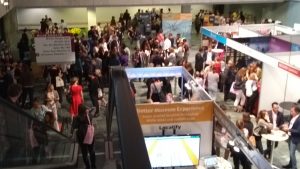What better way to muse on this question than attend one of the rather superb Museum Next conference series? So this June I set off for Rotterdam searching for inspiration, ideas and innovation.
The conference itself was very well put together. The first day offered great study tours around Rotterdam’s brightest and best – we were spoilt for choice. This was followed by two days with a diverse mix of plenary addresses, breakout presentations and workshops bringing together practitioners, academics, students and consultants from around the world. Again, spoilt for choice as we were forced to select from a very full programme with overlapping sessions.
While presentations focused on cultural attractions, and museums in particular (the clue is in the name), the debate ranged much more widely and from my point of view there was just as much inspiration to be had for visitor attractions generally but also for destinations. We know just how important cultural tourism has become as a driver of visits so there was much to learn and much to ponder .
For those who couldn’t make the event, spend some time trawling through the video archives of the Museum Next website and/or check out #museumnext on Twitter. I guarantee it will be time well spent. Also do consider attending a future event if you can. And at the very least follow @museumnext.
Here are a few insights that resonated for me. In no particular order:
Listen to different voices. At a personal level extend your network beyond those you like to those you respect. At a destination or organisational level actively solicit wider perspectives, even setting up new structures. A great example of this is the international experts invited onto Rotterdam Partners International Advisory Board, chaired by an ex-PM. The IAB only meets every 2 years but has 3 day immersive events with learning journeys around the city to really get under the skin. Rotterdam Partners has extended this idea into expert subgroups such as ‘IABx on Culture’ to explore putting Rotterdam on the map as a cultural destination; and their ‘Young Advisory Board’ of the city’s young entrepreneurs. See more here.
The idea of ‘big locals’. These are non-national institutions but which are of sufficient quality, status and capacity to build profile for the destination. They are the local champions capable of leading change and transforming a place. Which are your big locals?
View the museum experience differently. Why do we feel the need to see everything when we visit a museum or gallery rather than focus on one thing? Why do we arrange to meet someone repeatedly in the same place (park, café etc.) but view a museum visit as occasional or even one-off?
You don’t get if you don’t ask. Need tech help – or even a tailored tech system? Why not try asking the tech companies – many have Corporate Social Responsibility programmes and/or do pro bono work which gives good experience to employees. Maybe more of an opportunity if based in USA but could be worth a try.
Sweat your assets. Use your place as a learning lab for corporate team building, mentoring, professional development. I particularly liked some of the exercises suggested by Cindy Peterson of the Taubman Museum at Harvard University – observe an artwork, discuss, reflect on the approach, look at another artwork taking a different approach …; or come up with a new name for a colour; or for the institution. Nice!
Force yourself out of the same way of thinking. On a similar theme to the above point – art breaks existing patterns of seeing.
Stories are everywhere. The idea of ‘stories’ is in danger of becoming meaningless due to their current vogue but if you do want to pursue then think about how you deliver relevant, personal, impactful stories progressing from online, to virtual reality, to augmented reality to real time immersion.
Purpose not profit. Cultural institutions – and those who work in them – are driven by sense of purpose rather than a sense of profit. And that’s a good thing!
Elevating the role of museums. There was much discussion on this and the role that museums can play in everything from changing the world; reinventing the institution to make it a place for debating the big issues; seeing artists as 21st century community developers; providing a “place to reflect on how the future might be shaping up”. No shortage of ambition then.
Sponsorship. Look for creative collaborations rather than cultural organisations setting their plan and budget, finding there is a gap and search for a partner to fill the gap. This from one of Amsterdam’s young entrepreneurs Siobhan Berger who runs a company matching artists and companies and is involved in Rotterdam’s work on its cultural identity. She says it is important to identify that mutually beneficial relationship – and don’t take no for an answer, just find another question.
Listen to the young. I was blown away by the open stage session – an hour of 5 minute presentations most made by young practitioners under 30, who brought enthusiasm, insight and great ideas to the party. Check out in particular @museumdetox – a network of young BAME museum professionals based in London.
Final word goes to Adam Lerner, Director and Chief Animator of the Museum of Contemporary Art in Denver, who gave a witty, amusing and provocative talk on what museums are for and what they are capable of. He exhorted museums to be the best museum they could possibly be and make the best contribution they possibly could to their city as a place to live and visit.
Those of us working with places keen to grow cultural tourism know this to be a simple truth, and of course easier said than done.
